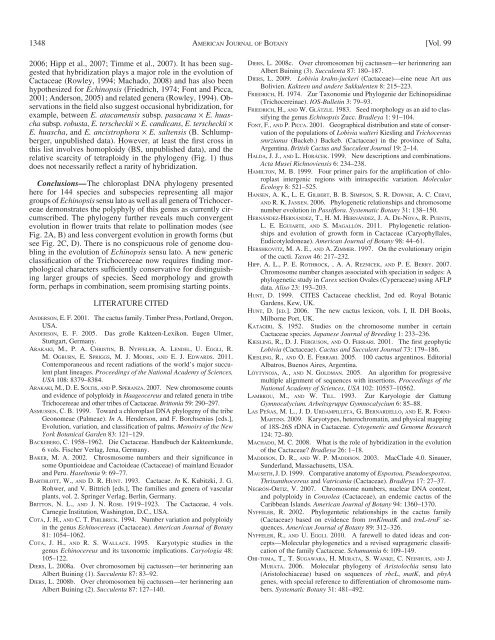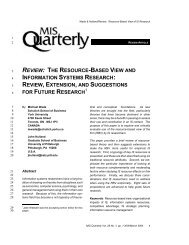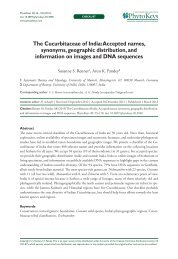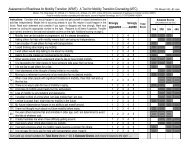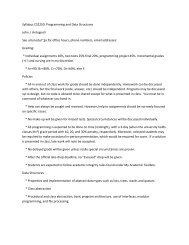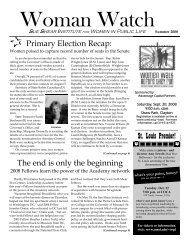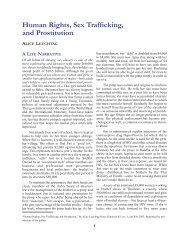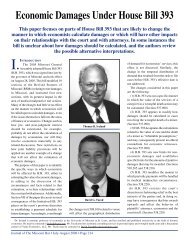molecular phylogenetics of echinopsis (cactaceae)
molecular phylogenetics of echinopsis (cactaceae)
molecular phylogenetics of echinopsis (cactaceae)
Create successful ePaper yourself
Turn your PDF publications into a flip-book with our unique Google optimized e-Paper software.
1348 AMERICAN JOURNAL OF BOTANY [Vol. 99<br />
2006 ; Hipp et al., 2007 ; Timme et al., 2007 ). It has been suggested<br />
that hybridization plays a major role in the evolution <strong>of</strong><br />
Cactaceae ( Rowley, 1994 ; Machado, 2008 ) and has also been<br />
hypothesized for Echinopsis ( Friedrich, 1974 ; Font and Picca,<br />
2001 ; Anderson, 2005 ) and related genera ( Rowley, 1994 ). Observations<br />
in the fi eld also suggest occasional hybridization, for<br />
example, between E. atacamensis subsp. pasacana × E. huascha<br />
subsp. robusta , E. terscheckii × E. candicans , E. terscheckii ×<br />
E. huascha , and E. ancistrophora × E. saltensis (B. Schlumpberger,<br />
unpublished data). However, at least the fi rst cross in<br />
this list involves homoploidy (BS, unpublished data), and the<br />
relative scarcity <strong>of</strong> tetraploidy in the phylogeny ( Fig. 1 ) thus<br />
does not necessarily refl ect a rarity <strong>of</strong> hybridization.<br />
Conclusions — The chloroplast DNA phylogeny presented<br />
here for 144 species and subspecies representing all major<br />
groups <strong>of</strong> Echinopsis sensu lato as well as all genera <strong>of</strong> Trichocereeae<br />
demonstrates the polyphyly <strong>of</strong> this genus as currently circumscribed.<br />
The phylogeny further reveals much convergent<br />
evolution in fl ower traits that relate to pollination modes (see<br />
Fig. 2A, B ) and less convergent evolution in growth forms (but<br />
see Fig. 2C, D ). There is no conspicuous role <strong>of</strong> genome doubling<br />
in the evolution <strong>of</strong> Echinopsis sensu lato. A new generic<br />
classifi cation <strong>of</strong> the Trichocereeae now requires fi nding morphological<br />
characters suffi ciently conservative for distinguishing<br />
larger groups <strong>of</strong> species. Seed morphology and growth<br />
form, perhaps in combination, seem promising starting points.<br />
LITERATURE CITED<br />
A NDERSON , E. F. 2001 . The cactus family. Timber Press, Portland, Oregon,<br />
USA.<br />
A NDERSON , E. F. 2005 . Das große Kakteen-Lexikon. Eugen Ulmer,<br />
Stuttgart, Germany.<br />
A RAKAKI , M. , P. A. CHRISTIN , B. NYFFELER , A. LENDEL , U. EGGLI , R.<br />
M. OGBURN , E. S PRIGGS , M. J. MOORE , AND E. J. EDWARDS . 2011 .<br />
Contemporaneous and recent radiations <strong>of</strong> the world’s major succulent<br />
plant lineages. Proceedings <strong>of</strong> the National Academy <strong>of</strong> Sciences,<br />
USA 108 : 8379 – 8384 .<br />
A RAKAKI , M. , D. E. SOLTIS , AND P. S PERANZA . 2007 . New chromosome counts<br />
and evidence <strong>of</strong> polyploidy in Haageocereus and related genera in tribe<br />
Trichocereeae and other tribes <strong>of</strong> Cactaceae. Brittonia 59 : 290 – 297 .<br />
A SMUSSEN , C. B. 1999 . Toward a chloroplast DNA phylogeny <strong>of</strong> the tribe<br />
Geonomeae (Palmeae). In A. Henderson, and F. Borchsenius [eds.],<br />
Evolution, variation, and classifi cation <strong>of</strong> palms. Memoirs <strong>of</strong> the New<br />
York Botanical Garden 83 : 121 – 129 .<br />
B ACKEBERG , C. 1958–1962 . Die Cactaceae. Handbuch der Kakteenkunde,<br />
6 vols. Fischer Verlag, Jena, Germany.<br />
B AKER , M. A. 2002 . Chrosmosome numbers and their signifi cance in<br />
some Opuntioideae and Cactoideae (Cactaceae) <strong>of</strong> mainland Ecuador<br />
and Peru. Haseltonia 9 : 69 – 77 .<br />
B ARTHLOTT , W. , AND D. R. HUNT . 1993 . Cactacae. In K. Kubitzki, J. G.<br />
Rohwer, and V. Bittrich [eds.], The families and genera <strong>of</strong> vascular<br />
plants, vol. 2. Springer Verlag, Berlin, Germany.<br />
B RITTON , N. L., AND J. N. R OSE . 1919–1923 . The Cactaceae, 4 vols.<br />
Carnegie Institution, Washington, D.C., USA.<br />
C OTA , J. H. , AND C. T. PHILBRICK . 1994 . Number variation and polyploidy<br />
in the genus Echinocereus (Cactaceae). American Journal <strong>of</strong> Botany<br />
81 : 1054 – 1062 .<br />
C OTA , J. H. , AND R. S. WALLACE . 1995 . Karyotypic studies in the<br />
genus Echinocereus and its taxonomic implications. Caryologia 48 :<br />
105 – 122 .<br />
D IERS , L. 2008a . Over chromosomen bij cactussen—ter herinnering aan<br />
Albert Buining (1). Succulenta 87 : 83 – 92 .<br />
D IERS , L. 2008b . Over chromosomen bij cactussen—ter herinnering aan<br />
Albert Buining (2). Succulenta 87 : 127 – 140 .<br />
D IERS , L. 2008c . Over chromosomen bij cactussen—ter herinnering aan<br />
Albert Buining (3). Succulenta 87 : 180 – 187 .<br />
D IERS , L. 2009 . Lobivia krahn-juckeri (Cactaceae)—eine neue Art aus<br />
Bolivien. Kakteen und andere Sukkulenten 8 : 215 – 223 .<br />
F RIEDRICH , H. 1974 . Zur Taxonomie und Phylogenie der Echinopsidinae<br />
(Trichocereinae). IOS-Bulletin 3 : 79 – 93 .<br />
F RIEDRICH , H. , AND W. GLÄTZLE . 1983 . Seed morphology as an aid to classifying<br />
the genus Echinopsis Zucc. Bradleya 1 : 91 – 104 .<br />
F ONT , F. , AND P. P ICCA . 2001 . Geographical distribution and state <strong>of</strong> conservation<br />
<strong>of</strong> the populations <strong>of</strong> Lobivia walteri Kiesling and Trichocereus<br />
smrzianus (Backeb.) Backeb. (Cactaceae) in the province <strong>of</strong> Salta,<br />
Argentina. British Cactus and Succulent Journal 19 : 2 – 14 .<br />
H ALDA , J. J. , AND L. H ORÁCEK . 1999 . New descriptions and combinations.<br />
Acta Musei Richnoviensis 6 : 234 – 238 .<br />
H AMILTON , M. B. 1999 . Four primer pairs for the amplifi cation <strong>of</strong> chloroplast<br />
intergenic regions with intraspecifi c variation. Molecular<br />
Ecology 8 : 521 – 525 .<br />
H ANSEN , A. K. , L. E. GILBERT , B. B. SIMPSON , S. R. DOWNIE , A. C. CERVI ,<br />
AND R. K. JANSEN . 2006 . Phylogenetic relationships and chromosome<br />
number evolution in Passifl ora. Systematic Botany 31 : 138 – 150 .<br />
H ERNÁNDEZ-HERNÁNDEZ , T. , H. M. HERNÁNDEZ , J. A. DE-NOVA , R. P UENTE ,<br />
L. E. EGUIARTE , AND S. M AGALLÓN . 2011 . Phylogenetic relationships<br />
and evolution <strong>of</strong> growth form in Cactaceae (Caryophyllales,<br />
Eudicotyledoneae). American Journal <strong>of</strong> Botany 98 : 44 – 61 .<br />
H ERSHKOVITZ , M. A. E. , AND A. Z IMMER . 1997 . On the evolutionary origin<br />
<strong>of</strong> the cacti. Taxon 46 : 217 – 232 .<br />
H IPP , A. L. , P. E. ROTHROCK , , A. A. REZNICEK , AND P. E. BERRY . 2007 .<br />
Chromosome number changes associated with speciation in sedges: A<br />
phylogenetic study in Carex section Ovales (Cyperaceae) using AFLP<br />
data. Aliso 23 : 193 – 203 .<br />
H UNT , D. 1999 . CITES Cactaceae checklist, 2nd ed. Royal Botanic<br />
Gardens, Kew, UK.<br />
H UNT , D. [ ED .]. 2006 . The new cactus lexicon, vols. I, II. DH Books,<br />
Milborne Port, UK.<br />
K ATAGIRI , S. 1952 . Studies on the chromosome number in certain<br />
Cactaceae species. Japanese Journal <strong>of</strong> Breeding 1 : 233 – 236 .<br />
K IESLING , R. , D. J. F ERGUSON , AND O. F ERRARI . 2001 . The fi rst geophytic<br />
Lobivia (Cactaceae). Cactus and Succulent Journal 73 : 179 – 186 .<br />
K IESLING , R. , AND O. E. FERRARI . 2005 . 100 cactus argentinos. Editorial<br />
Albatros, Buenos Aires, Argentina.<br />
L ÖYTYNOJA , A. , AND N. GOLDMAN . 2005 . An algorithm for progressive<br />
multiple alignment <strong>of</strong> sequences with insertions. Proceedings <strong>of</strong> the<br />
National Academy <strong>of</strong> Sciences, USA 102 : 10557 – 10562 .<br />
L AMBROU , M. , AND W. TILL . 1993 . Zur Karyologie der Gattung<br />
Gymnocalycium. Arbeitsgruppe Gymnocalycium 6 : 85 – 88 .<br />
L AS PEÑAS , M. L. , J. D. URDAMPILLETA , G. B ERNARDELLO , AND E. R. FORNI-<br />
MARTINS . 2009 . Karyotypes, heterochromatin, and physical mapping<br />
<strong>of</strong> 18S-26S rDNA in Cactaceae. Cytogenetic and Genome Research<br />
124 : 72 – 80 .<br />
M ACHADO , M. C. 2008 . What is the role <strong>of</strong> hybridization in the evolution<br />
<strong>of</strong> the Cactaceae? Bradleya 26 : 1 – 18 .<br />
M ADDISON , D. R. , AND W. P. MADDISON . 2003 . MacClade 4.0. Sinauer,<br />
Sunderland, Massachusetts, USA.<br />
M AUSETH , J. D. 1999 . Comparative anatomy <strong>of</strong> Espostoa, Pseudoespostoa,<br />
Thrixanthocereus and Vatricania (Cactaceae). Bradleya 17 : 27 – 37 .<br />
N EGRÓN-ORTIZ , V. 2007 . Chromosome numbers, nuclear DNA content,<br />
and polyploidy in Consolea (Cactaceae), an endemic cactus <strong>of</strong> the<br />
Caribbean Islands. American Journal <strong>of</strong> Botany 94 : 1360 – 1370 .<br />
N YFFELER , R. 2002 . Phylogentetic relationships in the cactus family<br />
(Cactaceae) based on evidence from trnK / matK and trnL-trnF sequences.<br />
American Journal <strong>of</strong> Botany 89 : 312 – 326 .<br />
N YFFELER , R. , AND U. EGGLI . 2010 . A farewell to dated ideas and concepts—Molecular<br />
<strong>phylogenetics</strong> and a revised suprageneric classifi -<br />
cation <strong>of</strong> the family Cactaceae. Schumannia 6 : 109 – 149 .<br />
O HI-TOMA , T. , T. S UGAWARA , H. M URATA , S. WANKE , C. N EINHUIS , AND J.<br />
M URATA . 2006 . Molecular phylogeny <strong>of</strong> Aristolochia sensu lato<br />
(Aristolochiaceae) based on sequences <strong>of</strong> rbcL , matK , and phyA<br />
genes, with special reference to differentiation <strong>of</strong> chromosome numbers.<br />
Systematic Botany 31 : 481 – 492 .


